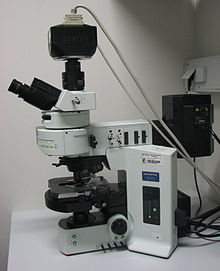
The absorption and subsequent re-radiation of light by organic and inorganic specimens is typically the result of well-established physical phenomena described as being either fluorescence or phosphorescence. The emission of light through the fluorescence process is nearly simultaneous with the absorption of the excitation light due to a relatively short time delay between photon absorption and emission, ranging usually less than a microsecond in duration. When emission persists longer after the excitation light has been extinguished, the phenomenon is referred to as phosphorescence.
British scientist Sir George G. Stokes first described fluorescence in 1852 and was responsible for coining the term when he observed that the mineral fluorspar emitted red light when it was illuminated by ultraviolet excitation. Stokes noted that fluorescence emission always occurred at a longer wavelength than that of the excitation light. Early investigations in the 19th century showed that many specimens (including minerals, crystals, resins, crude drugs, butter, chlorophyll, vitamins, and inorganic compounds) fluoresce when irradiated with ultraviolet light.
| Quantity:- 4 Nos |
| Zeiss Axio Imager.Z1 Widefield Fluorescence Microscope |
| Accessories:- |
|
ApoTome for optical sectioning Zeiss AxioVision 4.8 Zeiss AxioCam Mrm Digital CCD Monochrome camera |
| Zeiss Axioplan2 Widefield Fluorescence Microscope |
| Accessories:- |
|
Zeiss AxioVision 4.6 Zeiss AxioCam Hrc CCD color camera |
| Leica DMRXA2 upright microscope |
| Accessories:- |
|
Leica DFC 320 digital color camera Leica Application Suite imaging software |
| Olympus BX51 microscope |
| Accessories:- |
| MBF CX 9000 colour camera |
| Central and State Universities and Government of India/State Government Research Institutes/National Academic Institution | Unit |
| Rs. 1000/- | Per Hour |
| Email:- | soumya.nbrc@gov.in |
| Phone:- | +91 124-2845-200 |